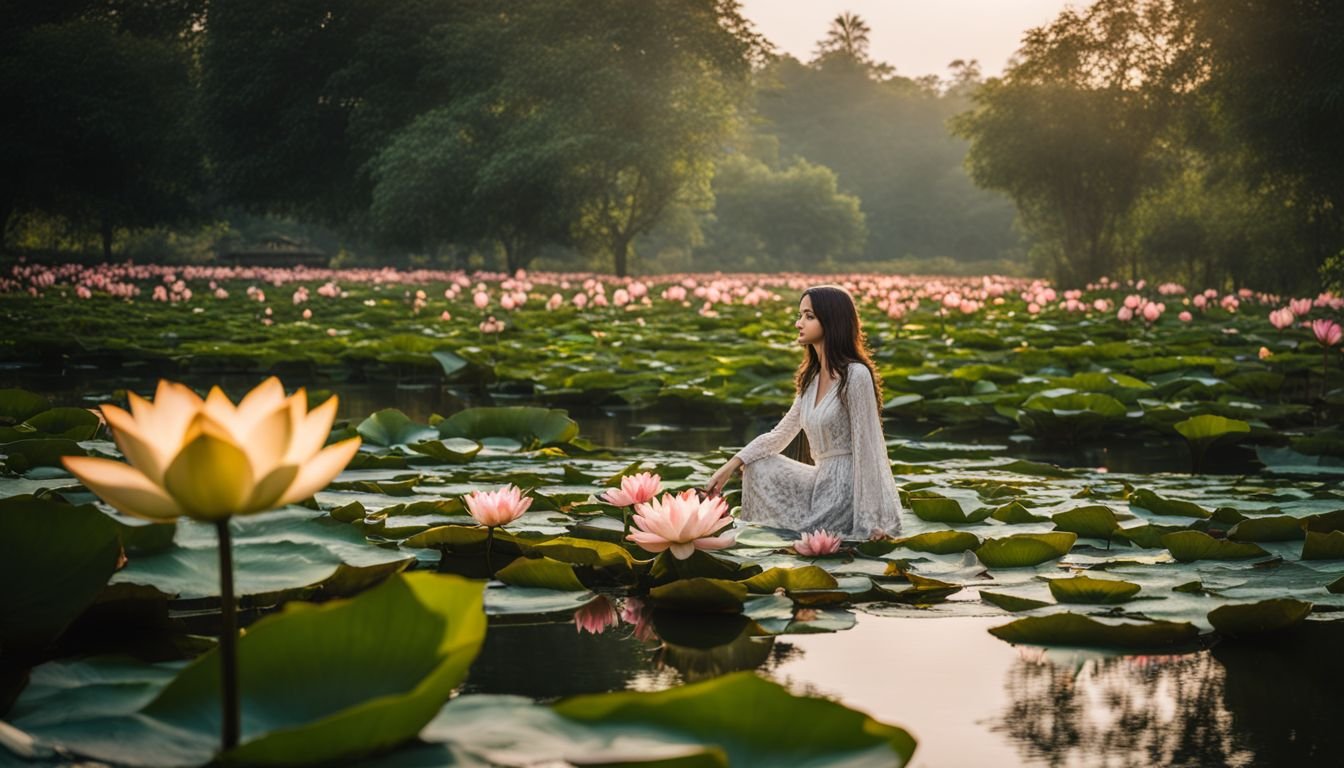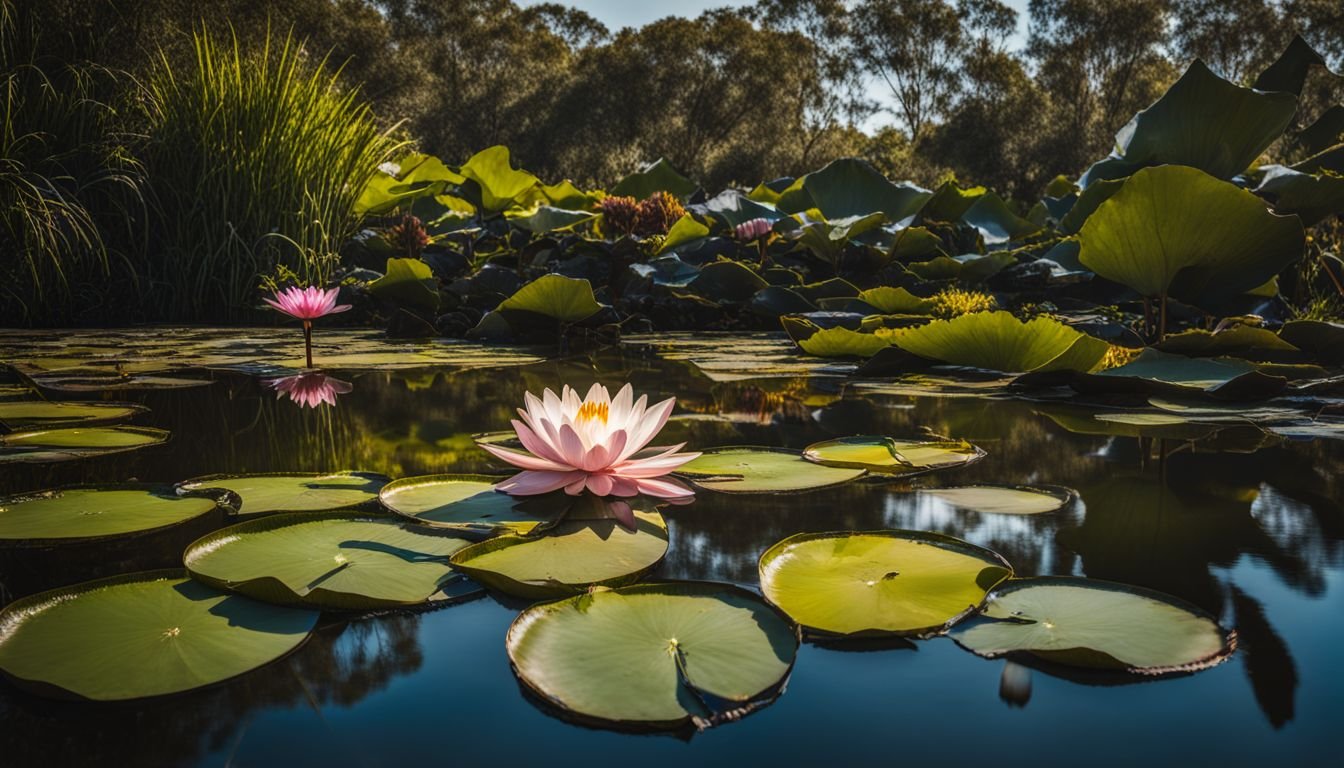Are you gazing into your garden pond, scratching your head about how to breathe life into it? You’re not alone, mate. Loads of Aussies grapple with this dilemma. They dream of vibrant water gardens but are stumped on which plants will flourish back there.
We’ve wandered down that garden path ourselves. Along the way, we stumbled upon two stunning aquatic gems: water lilies and lotus flowers. These aren’t just a feast for the eyes; they’re crucial cogs in the pond ecosystem.
Digging deeper into these plants threw up some fascinating insights – despite often being mentioned in the same breath, they’re as different as Vegemite and Marmite! From when they unfurl their blooms to their unique seed-sprouting antics, each boasts its own signature style.
Our yarn here spells out these contrasts in plain Aussie speak and shares why they’ve won hearts nationwide. Keen to see your pond become the talk of the neighbourhood? Stick around!
Key Takeaways
- Water lilies and lotus flowers, while often confused for each other, have distinct characteristics such as water lilies sitting on the water surface with pink hues and yellow centres, whereas lotus flowers stand above the water in a lighter shade of yellow.
- These aquatic plants play a significant role in pond ecosystems by offering shade to fish, reducing algae growth, stabilising soil to prevent erosion, and attracting pollinators like bees and butterflies with their blooms.
- Culturally important across various traditions, the lotus flower symbolises purity, enlightenment, and rebirth; water lilies represent creation and beauty. In Australia, they connect locals to ancient wisdoms through indigenous stories highlighting sacred water bodies.
- Thriving in Australian ponds requires calm waters where these plants can grow from rhizomes attached to the muddy bottom; they flourish best when planted 15 to 45 centimetres deep and relish plenty of sunlight.
- The presence of these plants enhances the aesthetic appeal of gardens by adding tranquillity and transforming ponds into serene escapes that bloom seasonally from June through October depending on the variety.
Identifying Water Lilies and Lotus Flowers

We can spot the difference between water lilies and lotus flowers by checking their petals and how they sit on the water. While both thrive in aquatic habitats, water lilies have pads that float and lotus flowers stand above the water surface.
Physical differences and similarities
Water lilies and American lotuses may look similar at a first glance, but they have distinct features that set them apart. Water lily flowers are large with pink hues and yellow centres, sitting on top of their broad leaves.
American lotus blossoms, however, come in a lighter shade of yellow with deeper yellow centres and stand tall on lengthy stalks above the water surface. Another notable difference lies in the leaves; water lily leaves feature a V-shaped notch and measure between 8-16 inches wide, while lotus leaves are rounder, larger, reaching up to 2 feet across.
Despite these differences, both aquatic plants share common ground. They grow from rhizomes nestled in soil underwater and thrive best when planted about 6 to 18 inches deep in ponds or lakesides.
Their lifecycles also present similarities – water lily flowers bloom splendidly for up to two weeks before submerging beneath the water’s surface upon wilting. Lotuses too show off their beauty before leaving behind significant seed pods that remain visible above the waterline long after the blossoms fade away.
“Both embody purity and transcendence by rising beautifully above murky waters.”
Exploring how these beautiful plants adapt to Australian ponds reveals even more about their nature.
Habitat and growth conditions in Australian ponds
In Australian ponds, both the water lilies and the sacred lotus thrive in calm, still waters. They start their life deep under water, attached to the muddy bottom with strong roots called rhizomes.
This foundation allows them to reach towards the light, displaying their beauty on the pond’s surface. These plants prefer these tranquil environments which are often found in private ponds and natural waterways across Australia.
Some species of water lilies are native to our lands while others have journeyed here to decorate our waters. The hardy water lilies and tropical varieties sometimes escape from gardens into wild areas, adapting well to local conditions.
Gardens across Australia also cultivate special breeds like nymphaea lotus and nelumbo nucifera for their unique appeal.
For these aquatic perennials to flourish, they need plenty of sunlight. Ponds that offer a mix of shade and sun help ensure that not only do these plants grow but they bloom beautifully as well.
Birdwatchers might find spots around these ponds particularly charming since birds often visit pools rich with aquatic vegetation like spatterdock or nymphaeceae family members.
The Symbolism and Cultural Significance of Water Lilies and Lotus Flowers

Water lilies and lotus flowers hold deep meanings across the globe, enchanting people with their beauty and mystical qualities. In Eastern traditions, the lotus flower stands for purity, enlightenment, and rebirth.
It’s remarkable how this bloom fights its way through murky water to show off its petals in the sun. This journey mirrors human struggle and triumph in many cultures. Water lilies also carry powerful symbolism.
They represent creation, fertility, and unparalleled beauty. These plants create a feeling of tranquility and peace wherever they grow.
Australian ponds serve as perfect homes for these symbolic blooms, connecting locals to a world of ancient virtues and wisdoms. Indigenous Australian stories often highlight water bodies as sacred places where life begins and flourishes because of these plants.
Both water lilies and lotuses are vital in spiritual ceremonies, art forms, and literature due to their rich symbolisms of eternal life and connection with the divine realm beyond our daily existence.
Their presence transforms Australian gardens into serene havens that mirror age-old tales of wisdom and virtue passed down generations.
The Ecological Role of Water Lilies and Lotus Flowers in Australian Ponds
Moving from the cultural depths that water lilies and lotus flowers hold, we find ourselves looking at their essential part in Australian pond ecosystems. These plants do so much more than just float gracefully.
Their large, round leaves offer shade and hiding spots for fish and other water animals. This not only keeps them safe but also cools the water on hot days. It’s fascinating how these floating gardens can cut down on algae, making ponds clearer and healthier for everyone living there.
The roots of these aquatic plants grip tightly to the pond bed, keeping soil in place which stops erosion. Think of them as natural anchors that protect our fragile pond banks against wear and tear caused by weather or moving waters.
And then there’s the magic happening above ground – their gorgeous blooms call out to bees, butterflies, and other pollinators. This brings life buzzing around our ponds, adding layers to the circle of life beneath the surface.
We often plant nymphaea lutea (pond-lily) at just the right depth because this helps keep everything balanced under water. Doing this allows them to play a role beyond beauty; they filter pollutants from the waters they live in.
Plus, once their flowers say goodbye, they enrich our aquatic homes with much-needed nutrients as they break down – a true full circle moment for ecosystem health.
The Beauty and Aesthetic Appeal of Water Lilies and Lotus Flowers
The sight of water lilies and lotus flowers in Australian ponds brings a unique charm. Water lilies, with their large, pinkish blooms and vibrant yellow centers, grace the water from July to October.
In contrast, American lotuses show off light yellow flowers with rich yellow hearts from June to September. The way these blooms sit or stand above the water adds a peaceful elegance to any garden pond.
These plants don’t just look pretty; they create an atmosphere of tranquility that draws us closer to nature. Lotus flowers rise on tall stems above the surface, while water lily flowers seem to float gracefully right atop their pads.
This visual spectacle transforms our ponds into living paintings that change through the seasons. Next up: understanding how these beautiful plants play a crucial role in our ecosystems.
Conclusion
Water lilies and American lotus flowers add breathtaking beauty to Australian ponds. Their bright blooms and vast green pads provide homes for fish and critters, playing a key role in our aquatic ecosystems.
They stand as symbols of purity in cultures around the world while bringing unmatched aesthetic appeal to our water gardens. With their unique growth habits, these plants invite us all to appreciate nature’s wonders right in our backyard.
Let’s cherish and protect these aquatic treasures for generations to come.
FAQs
1. What types of water lilies and lotus flowers can I find in Australian ponds?
In Australian ponds, you can spot tropical water lilies, the bonnet lily, the European white water lily, and various types of lotus like the blue Egyptian lotus and the Egyptian white lotus.
2. Do water lilies and lotuses bloom all day?
No, they don’t. Many water lilies are diurnal, opening their blooms in the morning and closing them at night. However, some varieties might have different blooming patterns.
3. Can I grow these flowers in my backyard pond?
Yes! With proper care including enough sunlight and clean water, you can grow beautiful pond-lilies like N. caerulea (Blue Lotus) or even a Proteaceae family member right in your backyard.
4. Are there any special features of these flowers that stand out?
Indeed! The “lotus effect” is fascinating; it refers to how lotus leaves repel water and stay clean. This feature also applies to many pond-lilies which have leaves that float on top of the water with a similar self-cleaning property.
5. How do these plants fit into cultural aspects or symbolism?
Water lilies and lotuses hold significant meanings across various cultures including Hinduism where they symbolise purity and beauty among other things due to their ability to emerge so elegantly from murky waters.
